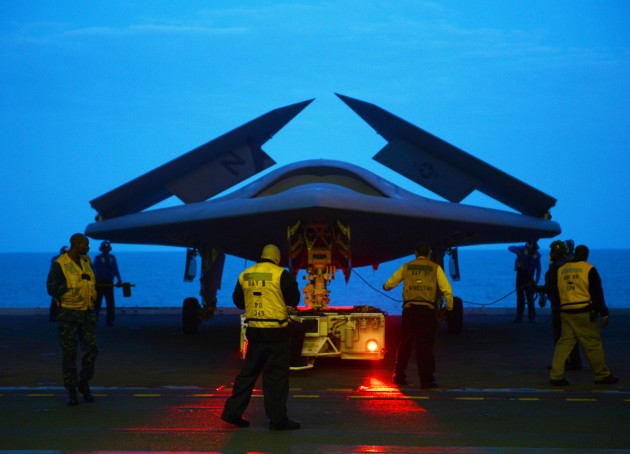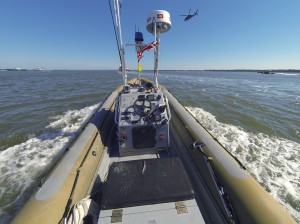Secretary Of Drones: Mabus Creates DASN For Unmanned
Posted on

The Navy’s UCAS demonstrator made history as the first drone to take off and land from an aircraft carrier.
UPDATED: Sen. McCain & Rep. Forbes Comment
NATIONAL HARBOR, MD: Navy Secretary Ray Mabus announced today that he’s reorganizing his department to increase emphasis on unmanned systems, from aerial drones to robotic mini-subs — a move which met with rapid approbation from Congress.
“I’m going to appoint a new Deputy Assistant Secretary of the Navy for Unmanned Systems,” Mabus said at the Navy League’s annual Sea-Air-Space conference here. On the uniformed side, the Chief of Naval Operations‘ staff will create a new section, N-99. Together, he said, these two organizations will “coordinate and champion…. all aspects of unmanned – in all domains – over, on and under the sea and coming from the sea to operate on land.”
This reorganization has the potential to put unmanned systems in the spotlight and bring them out of the shadow of larger, more established programs. Holding up a disposable mini-drone produced by a 3D printer, the CICADA, Mabus said unmanned systems “have to be the new normal.” For example, he said, “as good as it is, and as much as we need it and look forward to having it in the fleet for many years, the F-35 should be, and almost certainly will be, the last manned strike fighter aircraft the Department of the Navy will ever buy or fly.”
(This is a widely held sentiment, and it’s important the Navy Secretary shares it, but readers should remember that the decision on the next fighter, manned or not, will be made long after Mabus has left office.)

Navy Sec. Ray Mabus
“I was particularly encouraged” by the “last manned strike fighter” comment, Sen. John McCain said in a statement Wednesday evening lauding Mabus’s speech. “I hope the sentiments expressed by Secretary Mabus today will be reflected in the Navy’s future programmatic decisions.” The irascible Senate Armed Services chairman is a longtime critic of the F-35 Joint Strike Fighter. He’s also urged the Navy to make more ambitious strike goals for its future carrier-launched drone, the UCLASS.
“We’ve been arguing for a longer-ranged, more penetrating strike capability for UCLASS,” said Rep. Randy Forbes, chairman of the House seapower subcommittee, pointing to the danger of advanced air defenses like China‘s and the Russian S-300 being sold to Iran. But as long as UCLASS was just one more program in the airpower portfolio, competing with manned platforms and overseen by traditional pilots, he said, “I think there was a tendency to be a little more parochial, to have inertia in doing the things we’ve always done.” Pilots who grew up in manned aircraft don’t always appreciate the full potential of drones. It’s an old pattern, Forbes told me Wednesday afternoon: “The sail guys didn’t want to go to steam, the wood guys didn’t want to go to steel, and when we had the first carriers they just wanted them as ISR [intelligence, surveillance, and reconnaissance] vehicles.”
“I thought this was a good announcement,” Forbes said. “By standing up this new deputy assistant secretary, it’s going to give [unmanned systems] that kind of attention and focus. [It] is really a recognition by the navy of something we’ve been trying to get across to them for some time, that this technology is going to be very, very important.”
Other experts were more skeptical. Consolidating unmanned programs now scattered across the bureaucracy “could give senior leaders more visibility/control, I suppose,” one Hill staffer said, “but the downside is that it is just creating more bureaucracy.”
“This move apparently is designed to assure that unmanned aircraft get the attention they deserve in the acquisition and budgeting processes,” agreed defense industry analyst and consultant Loren Thompson, “However, if the portfolios for deputy assistant secretaries are going to be sliced so narrowly, the Navy may one day end up with dozens of such positions” — for jammers, for landing craft, etc. etc. “You see where this could lead.”
“This is about ringing together existing elements that exist within the department, within the OPNAV staff; this isn’t about creating a new bureaucracy,” said Thomas Hicks, the Navy Department’s deputy chief management officer, when I raised the question at a panel just after Mabus’s speech. “[It’s] bringing those together so we can have a unified way to approach unmanned, whether it’s above, on, or below the sea,” Hicks said. “What possibilities might you come to by looking at it more holistically like that vice, [for example] within the air community?”
“The technologies underlying [unmanned] undersea, surface, and air [systems] are agnostic,” the Chief of Naval Research, Adm. Mathias Winter, had said the day before at Sea-Air-Space. Whether an unmanned vehicle is moving through the air, under the water, over the surface of the water, or along the ground, he said, it can benefit from basic research into certain common areas: “sense and avoid [obstacles], persistence, autonomous behavior, power generation.”

A Navy patrol boat converted to operate unmanned as part of an Office of Naval Research experiment in autonomous “swarms.”
Innovation
Unmanned systems were the Navy Secretary’s primary but hardly sole example of his larger theme: innovation to protect America’s eroding high-tech edge. That anxious quest for innovation is driving Deputy Secretary of Defense Bob Work‘s Third Offset Strategy, aka the Defense Innovation Initiative. It drives much of the latest iteration of Under Secretary Frank Kendall’s Better Buying Power initiative, BBP 3.0. Mabus himself launched a “Task Force Innovation” in January, drawing on keen minds across the Navy Department at every level.
To help bring together isolated innovators across the fleet, Mabus also rolled out a new website, www.secnav.navy.mil/innovation — although he added ruefully that it’s still in beta. “We’re still working through some DoD red tape on getting it up-and-running,” he said to rueful laughter, “so we’ve identified the first place to start making things faster and easier!”
Information technology is prime example, but hardly the only one, of how the rate of advancement around the world is outpacing the Pentagon. “The world is getting faster,” Mabus said, “with, too often, the exception of the United States military,” caught as it is in “ever expanding, ever tightening coils of bureaucracy.”
For example, “the electromagnetic rail gun will finally be onboard a U.S. Navy ship” — specifically, the Joint High Speed Vessel Trenton — “in 2016, but only for testing, and only after several decades of development,” Mabus said. “That’s too long.” Even a simple idea like replacing the lights on Navy ships with energy-efficient LEDs took 12 years from when it was proposed by a non-commissioned officer in 2003 to when it actually began to be implemented.
Mabus wants to shortcut that process and reward personnel who accelerate innovation, with merit-based promotions, bonuses, and recognition. “This isn’t just about producing new platforms or weapons. It is a huge cultural change,” Mabus said. “It’s not only about what we make, it’s about how we think. It is about risk, and accepting risk by trying new ideas, some of which most assuredly will not work.”
“Institutionalizing innovation, institutionalizing change, is the hardest thing you can do in an organization,” Mabus said. “That doesn’t mean you ought not to try.”
Updated 9:10 am Thursday with note on when the next strike fighter will be decided.
Subscribe to our newsletter
Promotions, new products and sales. Directly to your inbox.
